A Complete Guide To Cleaning and Preservation of Coins, page 3
TRUE and FALSE PATINA on COPREOUS COINS, How To Cure "Bronze Disease"
TRUE PATINA
Patina is the final result, extending over years and often centuries, of highly varied external influences on copper and copper-base alloys such as bronze and brass.
In addition to the external chemical influences, patina formation depends upon the alloy involved and thickness of the copper-base alloyed metal surface.
NOTE: Contrary to popular usage of a term "patina", the initial patina of a copper-base alloyed coin is not deep green, light-green or blue-green. Patina is the surface oxidation that starts forming right away upon minting the coin and turns red-brown over time. But since this term has been loosely applied to all tones of coatings on copper-base alloyed coins, I will use the term for describing "true patinae" - an attractive coatings of green shades, on surfaces of such coins, which consist of basic forms of Verdigris.
The coatings of green, light-green or blue-green tones on copper-base alloyed coins are secondary layers of corrosion formed by foreign matter (dirt, sand, rust and similar materials, calcium, and various chemical compounds) or in combination with Copper Carbonate Hydroxide [Cu2(CO3)(OH)2] and crystalline Copper(II) Acetate - both are forms of Verdigris. True Patina therefore varies in color and has different forms, surfaces and thickness.
True Patina is formed essentially from the following influences:
• Green patina, leafy green to bluish green, can occur in the form of basic copper sulfate [CuSO4Cu(OH)2] from the sulfur dioxide content of urban air. In the vicinity of the ocean or sea, it can also contain copper chloride (CuCl) from salt dissolved in fog droplets or copper iodide (CuI, CuI2). It further results from air containing carbon dioxide, in combination with dirt and moisture, or from carbon dioxide in the soil in connection with organic acids and salts, and is then in the form of basic copper carbonate (CuCO3). Finally, green patina is a natural form of verdigris.
• Dark Green patina is a dark green Copper(II) Acetate [Cu(CH3COO)2], resulting from transformation of the copper oxide by Acetic Acid which is present in the atmosphere due to emission gases. Copper(II) Acetate is one of the forms of verdigris.
• Red patina, bright red through dark red to violet, consists of Cuprous Oxide (Cu2O) or Copper(I) Oxide produced by decomposition (reduction) of the Cupric Oxide (CuO) or Copper(II) Oxide formed initially. For example, this is caused by organic constituents of the soil.
• Brown patina is either a very thin film of red and black Copper Oxides formed through the action of oxygen, or it may be a thick mixture of green and red patina.
Buried copper-alloyed coins can be preserved in the soil extensively due to the absence of soluble salts, or because an equilibrium has been established between the corrosion and the neighboring soil. A small percentage of the buried coins never form the patina if they have been in a wet low or no oxygen environment that reverses oxidation. In the environment with low acidity, the coin metal may be perfectly preserved within a clay shell, and in the same condition - with a tone called "tiber patina", as it was when a coin was lost or buried.
Examples of Various Natural Patinae (not all) on Indian Head Cents
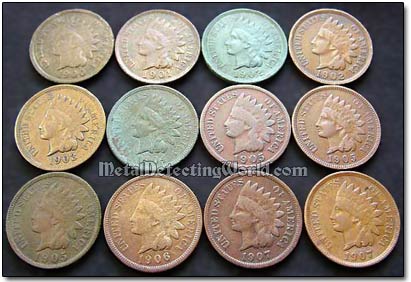
Tones of Green Patina on Dug Indian Head Pennies
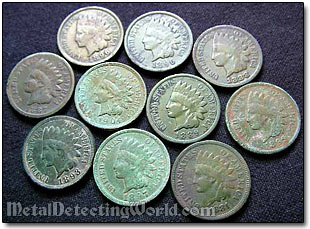
Reasons For Not Removing Natural True Patina Off Copper-Base Alloyed Coins
Natural patina is attractive, and since it is an indication of age giving old and ancient coins an antique look, it is generally allowed to remain on coins and other objects. If you intend to sell a coin in the future, you better keep the coin's patina intact because:
1) The patina protects the coin from further corrosion and Bronze Disease (described below).
2) Because a beautiful patina gives the coin an antique look and a character, it can increase the coin's value many times (stripping the patina off the coin can make it characterless and worthless).
3) Patina may hide pits on the coin's surface.
4) Very often the coin detail is in the patina, and removing it will reveal a nasty pitted and unattractive surface which lacks detail.
5) Removing patina does not return the coin to its original, uncorroded state, as it was when the coin was lost or buried. On the contrary, the coin gets reduced to whatever is left of the coin metal after some of it had been consumed by corrosion to form the patina.
FALSE PATINA
While the true patina gives a coin a rich and attractive appearance, "false patina" (not to be confused with ARTIFICIAL PATINA - see "Artificial Patination of Coins" page 23 for details) - encrustation with a patina-like appearance, not only obscures the coin's details which may have been already "eaten up" by it, but also might hide the ongoing corrosion processes underneath. The false patina can be of the following two types:
Type1: Excessive amounts of the secondary-layer coatings in forms of encrustation, deposits and accretions are cemented to the surfaces of copper-base alloyed coins. The cementing process that holds the encrustation to the coin's surface may be a part of the natural patination process. Vesicular, nodular, lumpy and wartlike encrustation and deposits on copper-base alloyed coins are considered unsightly and can be removed to give the coins decent looks.
However, in most cases of amateur or inappropriate cleaning of the heavy encrusted coins, the coins end up looking dreadful because, prior to cleaning, the corrosion processes have most likely damaged the coin surfaces coated with the thick verdigris coatings. Such an outcome of cleaning is common especially for the encrusted bronze and brass coins in which tin and zinc are the first metals to be attacked by corrosion. For example, corrosion of tin bronze with 6% of tin will cause appearance of Tin Oxide (SnO)- a dirty white or saltlike, or resembling clay or grease, material on a surface.
If the tin oxide has developed a weak layer underneath the coin's strong surface, and you begin soaking the coin in olive oil, the oil will start removing the tin oxide from under the surface; thus, weakening it. And then the weakened surface spots will go too leaving ugly indentations and pits, and the coin will be ruined!
In most cases of cleaning badly corroded copper-base alloyed coins to bare metal, the results are very disappointing: one can end up with a "dead" coin like the one on a picture below.
Thick Encrustation Was Removed To Reveal Ugly Pitting Caused by Long-Time Corrosion On Coin's Surface
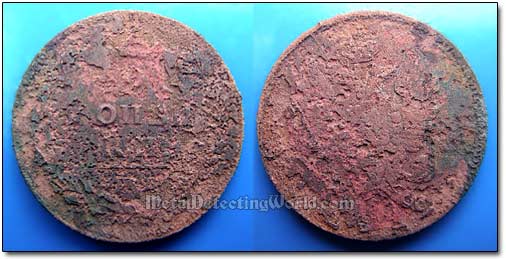
If your objective is to save the coin's true patina and remove only the thick verdigris coatings, you should use the method for removing the "bronze disease" encrustation, which is described below. Other methods of removal false patina of Type 1 are described on page 17 - method #12.
In contrast to the False Patina are Patina Imitations (artificial patinae) made with the aid of oil paints, lacquers, etc., or artificial patination with various chemical compounds (see "Artificial Patination of Copper Coins" on page 23).
Artificial Dark-Green Patina (Left Coin) and Remains of Natural Green Patina (Right Coin)
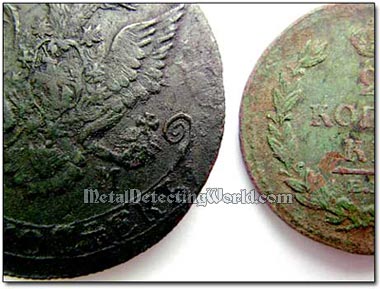
Type 2: The worst scenario is when a coin has been damaged by the chemical corrosion process that is commonly referred to as "Bronze Disease" (described on previous page). The signs of bronze disease are easy to confuse with the verdigris coatings. However, it is easy to distinguish the bronze disease accretions from the true patina of a copper-base alloyed coin as its true patina is normally uniform � it covers the entire coin's surface, its green tone is duller than the tone of the bronze disease coating, and is not crystalline.
You have a case of Bronze Disease if:
1) the green accretion occurs only in one or a few spots on the coin;
2) it is possible to scrape the crust off with a fingernail, a toothpick or hard toothbrush;
3) pitting and small indentations are present on the coin's surface and edge;
4) the green encrustation spots have light blue microscopic crystals.
Bronze Disease Encrustation On Copper-Base Alloyed Coin
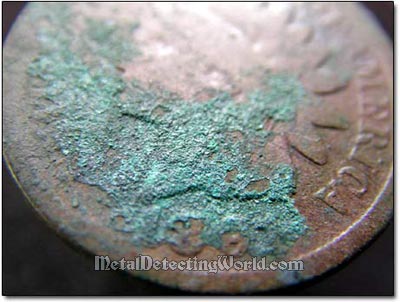
How To Remove Bronze Disease Encrustation and Deposits From Copper-Base Alloyed Coin
The main purpose of this method is to remove the Cuprous Chlorides or convert them to harmless Cuprous Oxide. If done carefully and without hurry, this method should not affect a true green patina on your coin; however, it will remove any artificial patina. To cure your "infected" coin, follow these steps:
1) With running water, apply a hard nylon brush to the coin's surface to remove as much of the encrustation as possible. Rinse and dry the coin.
2) With a magnifying light, apply a sharp bamboo skewer or needle to the remaining and still visible green "scabs" to remove or open them.
3) Prepare a "Soda Mix" of 5 teaspoons of Baking Soda (Sodium Bi-Carbonate) and 8 teaspoons of Washing Soda (Sodium Carbonate), mix thoroughly.
4) Prepare a solution for a hot bath by dissolving 6 teaspoons of the "Soda Mix" in 3 cups of deionized or distilled water.
5) Pour the solution in a glass container, add coin(s), heat the solution to boiling, and, as soon as it boils, reduce the heat to low and "simmer" the coin(s) for 10 minutes.
6) Set the bath aside and soak the coin(s) for at least 4 days. Take the coin out every day and brush it with a nylon brush, followed by rinsing with distilled water.
7) After the last soaking, dry and immerse the coin(s) into acetone or isopropyl alcohol for 30 minutes to drive any last remaining molecules of water from the coin's surface.
8) Dry the coin(s) thoroughly and coat it with microcrystalline wax, well rubbed into the coin's surface, to protect the coin from any possible adverse environmental influences. This treatment is a must if you are going to keep your bronze coins in an open display where a coating is deemed to be necessary. All copper-base alloyed coins, especially bronze ones, should be periodically examined for any changes on their surfaces. Since there is a possibility of Chlorine presence in the atmosphere, new "break-outs" of corrosion may occur and should be treated promptly. If the chemical action of the Cuprous Chlorides is not inhibited, copper-base alloyed coins will self-destruct over time.